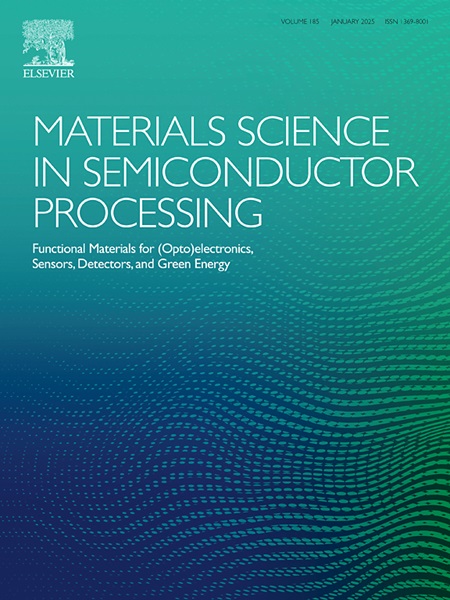Structural, electronic, and optical properties of copper doped monolayer molybdenum disulfide: A density functional theory study
IF 4.2
3区 工程技术
Q2 ENGINEERING, ELECTRICAL & ELECTRONIC
引用次数: 0
Abstract
We conducted first-principles calculations to investigate the effect of doping monolayer molybdenum disulfide (MoS2) with Cu in its structural, electronic, and optical properties. We found that Cu doping changes the material from an n-type semiconductor into a p-type semiconductor by shifting the Fermi energy level towards the valence band in all variations of concentration and site. The absorption coefficient, photoconductivity, and reflectivity calculations indicate that Cu-doped MoS2 is sensitive to violet light. In addition, Cu doping elevates the sensitivity of the material to low-energy light. These results show that Cu-doped MoS2 can be used in optoelectronic applications.
掺铜单层二硫化钼的结构、电子和光学特性:密度泛函理论研究
我们通过第一原理计算研究了单层二硫化钼(MoS2)掺杂铜对其结构、电子和光学特性的影响。我们发现,在所有浓度和位点变化中,铜的掺杂都会使费米能级向价带移动,从而使材料从 n 型半导体变成 p 型半导体。吸收系数、光导率和反射率计算表明,掺铜的 MoS2 对紫光很敏感。此外,掺铜还提高了材料对低能量光的敏感性。这些结果表明,掺铜的 MoS2 可用于光电应用。
本文章由计算机程序翻译,如有差异,请以英文原文为准。
求助全文
约1分钟内获得全文
求助全文
来源期刊

Materials Science in Semiconductor Processing
工程技术-材料科学:综合
CiteScore
8.00
自引率
4.90%
发文量
780
审稿时长
42 days
期刊介绍:
Materials Science in Semiconductor Processing provides a unique forum for the discussion of novel processing, applications and theoretical studies of functional materials and devices for (opto)electronics, sensors, detectors, biotechnology and green energy.
Each issue will aim to provide a snapshot of current insights, new achievements, breakthroughs and future trends in such diverse fields as microelectronics, energy conversion and storage, communications, biotechnology, (photo)catalysis, nano- and thin-film technology, hybrid and composite materials, chemical processing, vapor-phase deposition, device fabrication, and modelling, which are the backbone of advanced semiconductor processing and applications.
Coverage will include: advanced lithography for submicron devices; etching and related topics; ion implantation; damage evolution and related issues; plasma and thermal CVD; rapid thermal processing; advanced metallization and interconnect schemes; thin dielectric layers, oxidation; sol-gel processing; chemical bath and (electro)chemical deposition; compound semiconductor processing; new non-oxide materials and their applications; (macro)molecular and hybrid materials; molecular dynamics, ab-initio methods, Monte Carlo, etc.; new materials and processes for discrete and integrated circuits; magnetic materials and spintronics; heterostructures and quantum devices; engineering of the electrical and optical properties of semiconductors; crystal growth mechanisms; reliability, defect density, intrinsic impurities and defects.
 求助内容:
求助内容: 应助结果提醒方式:
应助结果提醒方式:


